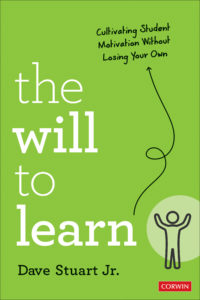Update from Dave: My new book is out, and it highlights ten practical methods for improving student motivation in all kinds of classrooms. One of those strategies is — you guessed it — Woodenize All of It. Get your copy here.
One of the best things you can do to help students put forth greater and more effective Effort is to teach them exactly what effective Effort looks like for the task at hand. And when you start to move in this direction, go all the way — leave nothing to chance.
John Wooden, the peerless UCLA college basketball coach of the 60s and 70s, began his career as a high school English teacher. Perhaps that is why he had such an instinct for teaching his students — and later his players — what he saw as the best ways for doing anything.
Famously, Wooden would begin his basketball seasons at UCLA by teaching his college athletes — grown men of 18 or 19 or 20 or 21 years of age — to put on their socks and tie their shoes. He wouldn't just mention that this was important to get right; he'd model the behavior explicitly, doing it right along with them and checking for understanding as he went.
Here's Wooden telling Newsweek journalist Devin Gordon about this during the later years of his life:
I think it's the little things that really count. The first thing I would show our players at our first meeting was how to take a little extra time putting on their shoes and socks properly. The most important part of your equipment is your shoes and socks. You play on a hard floor. So you must have shoes that fit right. And you must not permit your socks to have wrinkles around the little toe — where you generally get blisters — or around the heels. It took just a few minutes, but I did show my players how I wanted them to do it. Hold up the sock, work it around the little toe area and the heel area so that there are no wrinkles. Smooth it out good. Then hold the sock up while you put the shoe on. And the shoe must be spread apart — not just pulled on the top laces. You tighten it up snugly by each eyelet. Then you tie it. And then you double-tie it so it won't come undone — because I don't want shoes coming untied during practice, or during the game. I don't want that to happen. I'm sure that once I started teaching that many years ago, it did cut down on blisters. It definitely helped. But that's just a little detail that coaches must take advantage of, because it's the little details that make the big things come about.
(Source)
I've shared this story about a million times with teachers it seems. I find it profoundly instructive.
- He's respectful. This isn't a lesson because he believes his players are stupid; it's a lesson because he believes they are important. He wants not an ounce of their effort to end up wasted because he's in touch with the reality that they are living once-in-a-universe lives.
- He's clear. The details in his retelling here are wonderful. There's talk of little toes and wrinkles and lace eyelets and tying methods. I like to picture him in the locker room going over this; I like to picture the new players to the team looking around for a hidden camera to see if this is all some kind of joke.
- He owns it. Wooden knows there's more than one way to put on a sock or tie a shoe. And yet, he's not bashful about saying, “This is how I want you to do it.” He takes on the mantle of teacher — no light load, but one that's hanging in our classrooms regardless of whether or not we decide to shoulder it.
- He does this once. The key with explicitly teaching small behaviors like this is that you do it one time, as briefly as you can, using modeling or note-taking to make things clear and explicit. And then afterwards, you have just one job: relentless reinforcement.
- If you teach students to capitalize proper nouns and then you see someone not do it — do what you said you'd do. Address it. Point at it. Gently say, “That's something we check twice for.”
- If you teach students to enter the room a certain way, and then students don't — you don't let it slide today because you're in a good mood. You address it — politely, firmly, warmly, authoritatively. Because this is the way that you've found works best.
All I'm saying is this: if there's a learning-conducive behavior you want students to do well, Woodenize it. Make it clear. Give it airtime.
Woodenize all of it.
Best,
DSJR

Pamela L Volker says
You are right about John Wooden. His attention to the little things made a big difference in the lives of his players, and in mine – his secretary during a summer basketball camp. Everytime I think of him it warms my heart!
davestuartjr says
Pamela, I am so jealous! 🙂 And so grateful to have you write in 🙂
Lori says
So often these days, we leave so many options open for kids and expect them to make the best choice when we already know the answer in many cases. Kids want structure and guidance. Kids need structure and guidance. There is a time and place for options, don’t get me wrong. BUT, it is our job to provide that guidance in their world where they are already overwhelmed.
Dave Stuart Jr. says
YES.